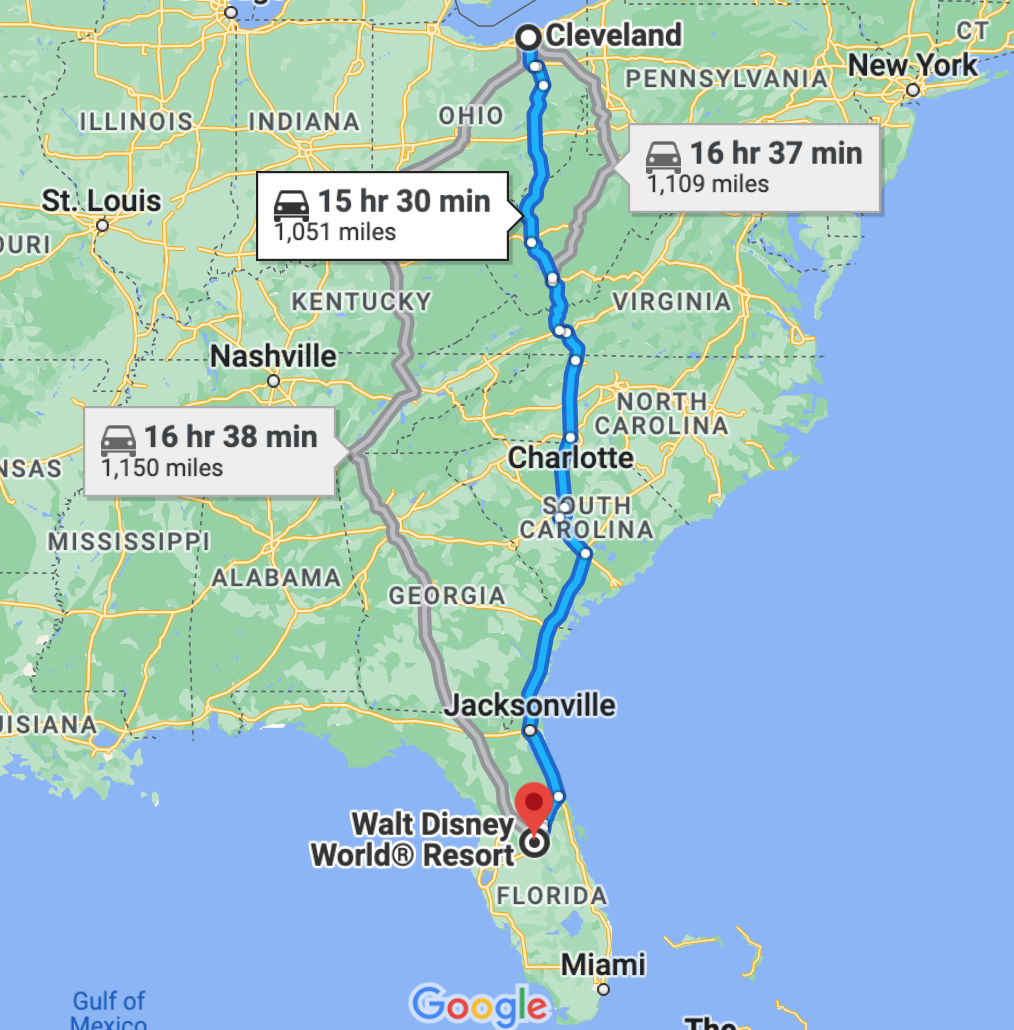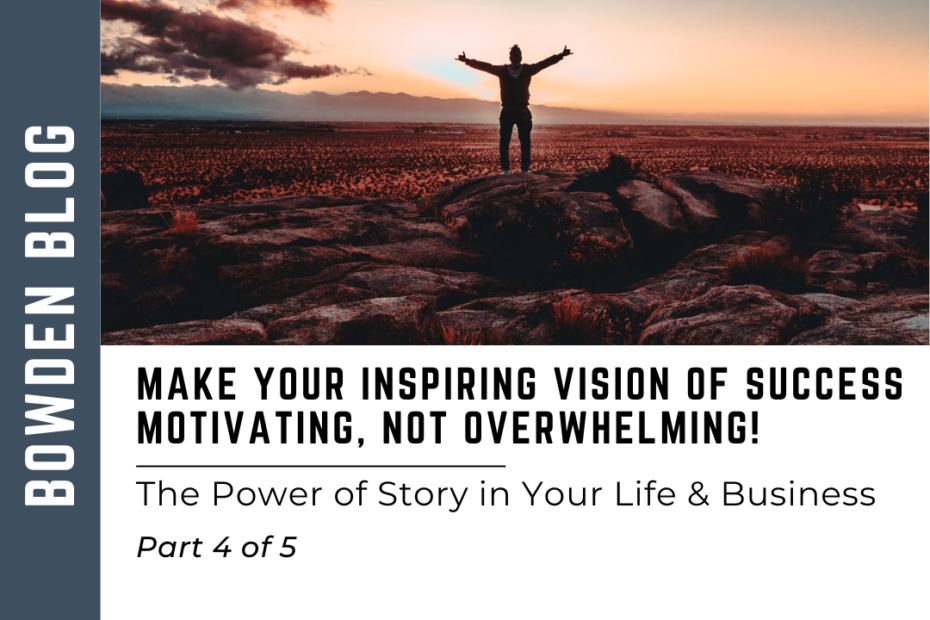What’s Your Story? Using the Power of Story to Frame Your Life & Business
part 4 of 5
Living Into Your Story – Make Your Inspiring Vision of Success Motivating, Not Overwhelming!
Long Journeys Can Be Emotionally Challenging
“Are we there yet?”
Did your kids ever ask you that question ten minutes from your house on the way from Cleveland to Disney World?

When I was a kid and asked that question, my grandmother would respond by saying that “It’s just down the road a little piece.” Even when it’s a great adventure with a fabulous destination, starting a long trip can seem daunting in the early stages if you’re only focused on the end goal. Pre-defining waypoints can help manage your emotions along the way. This makes the journey inspiring rather than tedious or disheartening.
Engage Your Emotions to Keep Your Story Going
Previously in this Series, we talked about taking ownership of your Self-Image and playing the role of Hero in your own story. Last week, we reviewed the importance of crafting a detailed picture of your destination to activate the Power of Story to get you actively engaged in a compelling narrative in that direction. This week, we’ll discuss the challenges of living into Big Goals that could seem daunting at the outset, so that your emotions help keep you energized throughout the journey.
The Power of Story is derived from the emotion you experience as a human being. A compelling story engages you through the ups and downs of the Hero’s path. If you think of your favorite stories, you’ll recognize that the victory being sought often seems unreachable at the outset.
The child 10 minutes into the drive asks “Are we there yet?” because the destination is still out of sight. The next question “Are we ever going to get there?” isn’t too far off. The parent in the car might suggest, “We’ll be in West Virginia in about 4 hours”… an initial waypoint. Or they might list the states between Cleveland and Orlando. Knowing they need to transit Ohio, West Virginia, Virginia, North Carolina, South Carolina, and Georgia before they make it to Florida, helps provide even more waypoints. It doesn’t make the trip any shorter, but it usually makes it “feel” shorter. The same principle applies to our favorite Stories, as the Hero moves through the steps to achieve the goal.
When you’ve crafted your Big Goals in detail, hopefully, it’s an outcome that’s inspiring to you. Most people fail to identify their desired outcome, and fewer still take the time to write it down. Crafting your Story’s climax is important as it provides the initial emotional content required to start your journey, but too many folks that have Big Goals end up giving up and dismissing them as fantasies. Their emotional engagement fades because the stretch to their outcome that once seemed energizing, ultimately feels impossible. All that might have been lacking was a series of waypoints to keep their emotional engagement high, by making each step “feel” attainable. It wouldn’t have made the Big Goal any easier to achieve, it just could have made it seem that way.
Three Keys to Crafting Waypoints for Your Story:
1. Bridge the Time Gap
Thinking of achieving your Big Goals should feel like a journey. Even if your physical location doesn’t change, over time it will become a different place. The march of time impacts your surroundings and capturing those anticipated changes along the way is an important way to measure your progress over time. You will grow your way to your Big Goals and thoughtfully considering indicators of progress along the way will be important.
When you establish your Big Goals, they are far away from who you are today, and achieving them will represent a new aspirational Self-Image for you. The difference between your current Self-Image and the aspirational one is called Cognitive Dissonance. It’s what drives your change. Your mind will work, largely unconsciously, to bring the two Self-Images together to reconcile the Cognitive Dissonance.
One of two ways that will happen:
- You’ll unconsciously move toward your new Self-Image.
- You’ll unconsciously reject your new Self-Image and move back to your previous Self-Image.
Cognitive Dissonance is required to drive change, but if it’s too big of a stretch, rather than changing you to meet the new Self-Image, your mind won’t believe you can make it, and drive you back in the opposite direction.
Big Goals tend to take decades to achieve, so clarifying an early waypoint helps keep the Cognitive Dissonance achievable. Creating a few more waypoints further out can help you see the shape of your Story arc.
One example of bridging the time gap would be establishing what you should expect 1 year, 5 years, and 10 years from today.
2. Consider the Behaviors Required at Each Phase of the Journey
Growing to achieve your Big Goals will require new behaviors along the way. If you were already doing those behaviors, you’d already have met your Big Goals. Imagining what you’ll be doing and how you’ll feel at each phase of the journey, particularly with aspirational intentions, will help you live into your Story.
Here are a few idea starters that might help:
- Who do you spend time with?
- What are you doing every day?
- What have you completely stopped doing?
- What family activities are you doing?
- What business role are you playing?
- How do you spend your free time?
- Where do you find your greatest enjoyment?
The answers to these types of questions evolve over time as you live more life. The more clearly you can picture the scenes, the more emotionally engaged you’ll be along the way.
3. Plan to Refresh the Waypoints at Regular Intervals Along the Way
Starting today with Big Goals and waypoints in place is important, but what story have we heard that went exactly according to plan? Of course, the answer is “None!”
Expect that you’ll have to reassess along the way as unpredictable events happen. Some of the best stories come out of unexpected events, especially new challenges. Certainly on the heels of the pandemic, building the waypoints of your Story should include an allowance for recalibration for unforeseen interruptions.
General Patton famously said, “In preparing for battle I have always found that plans are useless, but planning is indispensable.” In planning your future, the process is important, and know that you’ll want to systematically update your waypoints along the way. Hopefully, as you approach your Big Goals, your perspective on them will get clearer.
Final Thoughts
Harnessing the Power of Story for your Life & Business is enhanced by establishing proper waypoints to keep your emotions engaged along each stage of the journey. You reflect on your inspiring Big Goals but focus on the moment on getting to the next waypoint. Properly done, you can’t help but be energized as you live into your Story in this way!
Next week, we’ll wrap up our Series talking about the daily & weekly rhythms that will be the final piece to get in place so you can use the Power of Story to frame your Life & Business.
An Opportunity – Our Free Webinar
If this Series has gotten you interested in the Power of Story and how to use it in your life, our webinar next week is an opportunity for you. I’ll be hosting a 90-minute virtual session with my fellow business coach, Lori Hastings, on Wednesday, November 9th at 1:30 pm EST. We’ll explore these principles, answer questions and give you the tools you can use to head into 2023 with a fresh Story that you can live into with enthusiasm. Join us!

